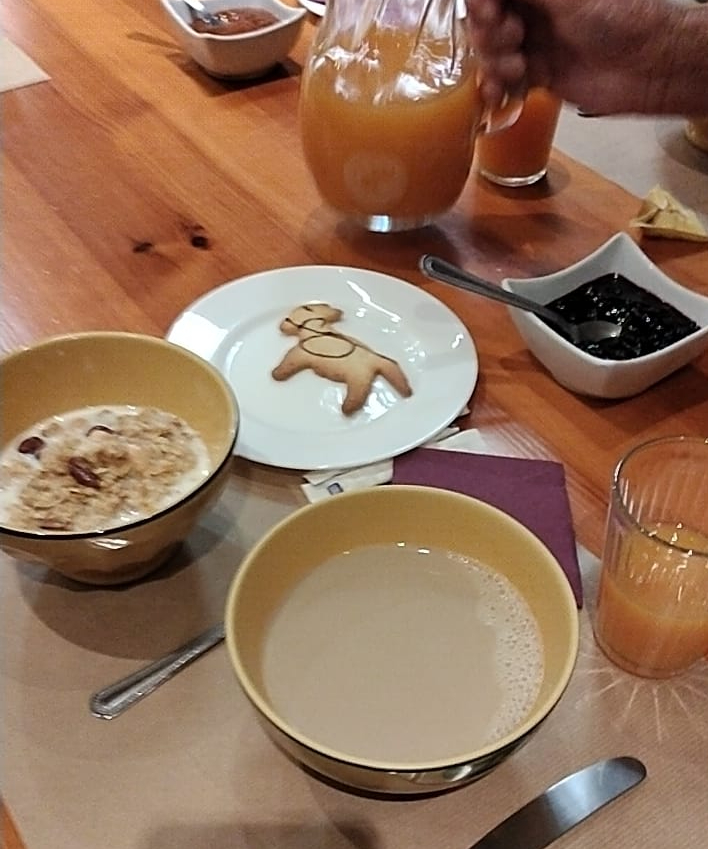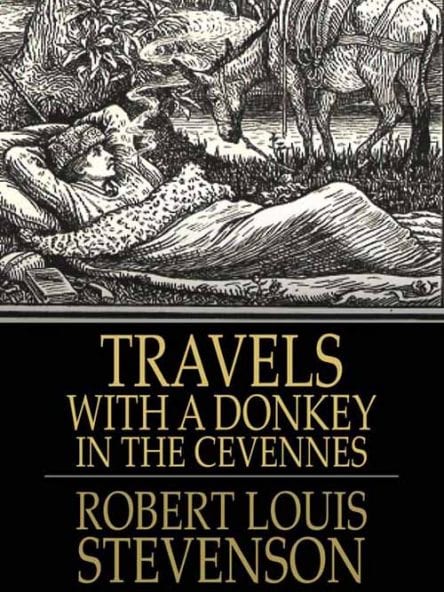* * * *

* * * *
The last post said this post would have more on the hike to St. Etienne, “with various trials and tribulations we went through getting there,” so here goes. We left Cheylard-l’Évêque and headed to Saint-Étienne-de-Lugdarès. The hike ended up totaling 12 miles or more, but that included an extra 4.9 miles off the Trail. (One way, per Google Maps, and I believe it.)
Before leaving Tom checked his guidebook and saw there were no “coffee cups” along the way. (John Brierley‘s guidebook for Caminos de Santiago uses a small pink coffee cup to signify an open cafe along the way.) So before leaving Cheylard’s Refuge du Moure we took up the hostess’s offer for packed lunches at eight Euros apiece.
From there the day started off well.
In the morning we passed through beautiful horse country, heading to Luc. Lots of wide green fields and pastoral grazing herds, but we could also see steep hills on the horizon. “We have to climb up and over that?” Also lots of that slippery-rock trail like we’d seen so much so far. Watch each step, “Careful! Don’t step there!” Lots of potential knee-wrenching, ankle-twisting careful foot-placing. (One reason for us being lucky to make a mile and a half an hour.) But the sky was a deep blue and the wind down around those green pastures wasn’t too bad.
Then we entered FORET DE MERCOIRE, Mercoire Forest, where we passed much of the day. “Primeval, Pacific-coast type rain forest.” That was my take on it, but the website added some interesting notes. “Relax in the peace and quiet of this huge and enchanting forest … where the river sources of Moure de la Gardille (1503m), Allier, Langouyrou and Chassezac all begin.” Along with this, “In the 18th century, Mercoire Forest is where many people fell victim to the Beast of Gévaudan.” (Of which more at our destination, Saint-Étienne-de-Lugdarès.)
The guidebook showed the GR-70 turning south at Luc, near the end of what is normally a day’s hiking quota. But Tom couldn’t find suitable lodging there, so once we got to Luc we had to keep heading east, off the Trail. That added the extra 4.9 miles, which doesn’t sound like much but makes a big difference at the end of a long day lugging a 20-pound pack.
But first we stopped at Château de Luc – shown above – for a break. We explored the castle ruins at some length before proceeding on. The tower had some great views of the surrounding countryside. Then after clambering around a bit we got back on the Trail, down through Luc. There we lucked on to a mom-and-pop gite, where I enjoyed another Bière blonde La Stevenson. (Like the one back in Brugeyrolles the evening of our first day off.) But unfortunately, the place had no restrooms. I tried to pass through some wooly curtain-like things at a door marked privé, but the lady yelled “No, no!” And that wasn’t the end of the story…
Back on the Trail, or rather off the Trail for that extra 4.9 miles. The place Tom reserved for the night was right across from Eglise St Etienne and – according to Google Maps – the hike should take an hour and 48 minutes. (Assuming you don’t stop.) But first you have to cross over D906, a busy main highway, then get on D19 (Luc Village), then head northwest and cross a bridge over the Allier River. (Separating Lozere from Ardeche.) Then you head back southeast, down past where you started, to where Le ruisseau Masméjean flows east from the Allier.
At first it was a nice change walking on paved highway. Lots of paved highway. But somewhere along there I remembered hearing the human foot is not designed to walk on asphalt or such hard surfaces – and I came to believe it. Then too something I’d eaten started “disagreeing.” I was in agony for a while, until I finally called ahead to Tom for a short break. Then came a steep scramble down into the trees that lined the road. (Beside the babbling ruisseau.) I remember a log and lots of bramble bushes, maybe poison ivy? My shins and calves ended up covered with itchy scratches, but they healed up in a day or two. Anyway, once it was all over – “let the reader understand” – I scrambled back up to the highway feeling lighter and better.
From that point it wasn’t too far to our lodging. “We got here at the crack of 4:40 p.m.” At the B&B – right across from Église Saint-Étienne – we got two separate rooms, one for the guys and one for Carol,. (Not a tiny room, beds jammed together like the night before.) The hosts said they had good internet but we never did figure out the password. Lots of “gaudy stylized letters and numbers.” At dinner the hostess explained the town was birthplace of the original Papillon, and that the famous – or infamous – “Beast of Gevaudan” claimed his first victim there.
From there – Sunday, the 24rh – we faced a long hike to La Bastide-Puylaurent. (A name including the “puy” that means another volcanic hill.) But first we had to get back to the Stevenson Trail itself, in Luc, and didn’t relish paying for the same real estate twice. (Hiking back that extra 4.9 miles, adding significantly to the day’s total.) Which we mentioned to the nice lady hostess, who proceeded to volunteer her husband to drive us back to Luc. Which he did, after we stowed our packs in the rear and jammed into the small French sedan. Only to find out Carol had left her phone back at the lodging, which would have been a much bigger pain if we’d discovered that while hiking back to Luc. But the husband was pretty mellow and things worked out.
A side note: A mile and a half east of Bastide – where we were headed – is the Trappist monastery Notre-Dame-des-Neiges (Our Lady of the Snows), “visited by Robert Louis Stevenson … and described in his book Travels with a Donkey in the Cévennes.”
We didn’t visit the monastery but the place we stayed at had good internet – internet we could actually get on – plus a great dinner. “Only one choice, but what a choice!” But that’s a story for next time, along with more interesting incidents. (But no “gang aft aglay” for a change.)
In the meantime I just ran across this photo from that “Camping Above the Clouds,” which gives a better idea of how beautiful and spiritually freeing it was. More adventures to come…
* * * *

* * * *
The upper image is courtesy of Château de Luc – Wikipedia.
For this post I referred to Gearing up for the Stevenson Trail in France, from May 27, 2023, and The Stevenson Trail – from Le Puy to La Bastide-Puylaurent, from September 3, 2023, a week before I flew out, September 10. (Arriving in Paris on the 11th.” Also, Dreams, maps and reality – hiking in France, 2023, from October 28, 2023, after we all got back from the trip.
The French ruisseau translates to brook or small stream. I couldn’t find a translation for Masméjean.
The full “Mercoire” link is FORET DE MERCOIRE – CHEYLARD-L’EVEQUE | Lozère Tourism.
“Paying for the same real estate.” See Not me. I don’t like to pay for the same real estate twice, on General Patton’s not wanting to “to fall back and regroup” during the Battle of the Bulge.
Re: Distance from Luc to Bastide. The straight-south route- along the highway – is a bit over four and a half miles. The official GR-70 route turns southeast at Laveyrune, then east to Notre-Dame des Neiges, then back west to Bastide, for a total of 9.8 miles. (Which figures into the next post.)
The lower image is courtesy of Camping | Camping Au-Delà des Nuages | Rauret, a place I earlier identified as “Arquejols.” (I covered our stay there in From Monistair to “East of Langogne.) That is, we stayed there the third night out, the night before we got to “east of Langogne” and our first day of from hiking, after four days. But I just found this link while writing up my book on the 2023 journey. The website leads with this: “Living in Harmony with Nature. Lovers of Mother Nature, we offer a service aligned with our values: All our infrastructures are made from local wood.” (They also offered a nice seven Euro bottle of Tarnac IGP Cevennes Blanc 2021 Wine.
* * * *



